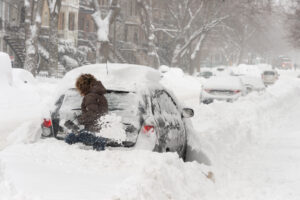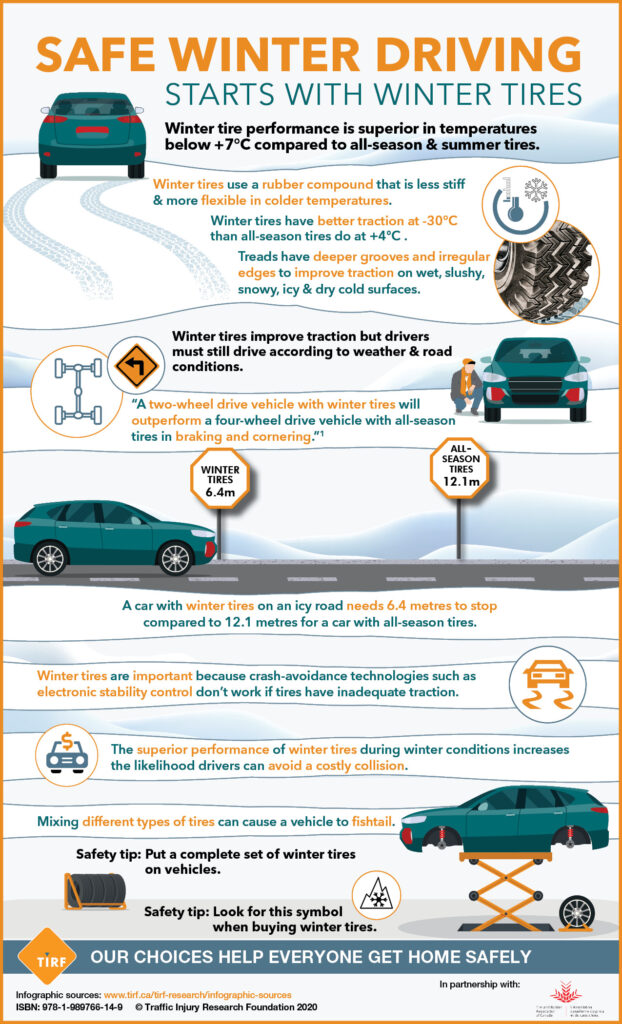It’s not just about snowfall, once temperatures dip to +7°C, winter tires are the way to go.
 Long, cold, snowy winters are familiar to most Canadians, except perhaps those who would typically head to warmer climates around this time of year. But, remember when border closures, travel restrictions and safe choices to prevent the spread of COVID-19 meant most snowbirds stayed north of the border. Now, it’s the cost that may be keeping snowbirds north of the border. For those looking for a more temperate Canadian winter experience, areas of BC like Vancouver Island are appealing. But, for these snowbirds, (and, even long-time residents) winter driving conditions may come as a bit of a surprise even with choosing the West Coast to ride out winters.
Long, cold, snowy winters are familiar to most Canadians, except perhaps those who would typically head to warmer climates around this time of year. But, remember when border closures, travel restrictions and safe choices to prevent the spread of COVID-19 meant most snowbirds stayed north of the border. Now, it’s the cost that may be keeping snowbirds north of the border. For those looking for a more temperate Canadian winter experience, areas of BC like Vancouver Island are appealing. But, for these snowbirds, (and, even long-time residents) winter driving conditions may come as a bit of a surprise even with choosing the West Coast to ride out winters.

Whether a ‘stranded’ snowbird or a winter weather expert, Canada is a large country and based on the annual avalanche of east coast versus west coast #snowstorm memes, each province has an entirely different experience when it comes to winter weather. Vancouver’s, ‘But, it’s a wet cold?!’ cannot be compared to Montrealers shovelling through 4’ of packed snow before leaving for work just to have to shovel it again before being able to pull back into the driveway at the end of the day. In fact, it often becomes a friendly competition and point of pride to boast which province lays claim to the biggest snowfall of the season.

From St. John’s to Vancouver, ‘expect the unexpected’ becomes more than a catchy phrase as drivers look forlornly between their summer tires or all seasons and the rising snowfall while strategizing how to get to work or the store. Many discover the hard way that not all all-seasons are actually for all seasons if they don’t have the coveted snowflake rating as found with winter tires or at least an M+S (Mud + Snow) rating which, by the way, is still not as effective as a complete winter tire. So, what’s the best choice and why? TIRF’s new Safe Winter Driving Starts with Winter Tires infographic is here to help.
This infographic comes following many years of our winter tire report maintaining its place as one of our most downloaded documents around this time every year. This infographic answers some of the common questions about why winter driving requires winter tires and most importantly, why winter tires will help you get home safely. It’s imperative drivers understand winter tires improve traction, but drivers must still drive according to weather & road conditions. A University of Michigan report found, “A two-wheel drive vehicle with winter tires will outperform a four-wheel drive vehicle with all-season tires in braking and cornering.”
Facts about winter tires versus all-season and summer tires
Winter tire performance is superior in temperatures below +7°C (yes, that’s PLUS SEVEN) compared to all-season and summer tires.
- Winter tires use a rubber compound that is less stiff & more flexible in colder temperatures.
- Winter tires have better traction at -30°C than all-season tires do at +4°C.
- Treads have deeper grooves and irregular edges to improve traction on wet, slushy, snowy, icy & dry cold surfaces.
- A car with winter tires on an icy road needs 6.4 metres to stop compared to 12.1 metres for a car with all-season tires.
- Winter tires are important because crash-avoidance technologies such as electronic stability control don’t work if tires have inadequate traction.
- The superior performance of winter tires during winter conditions increases the likelihood drivers can avoid a costly collision.
When it comes time to book your vehicle in the shop for the switch to winter tires, be sure to put on a complete set of winter tires because mixing different types of tires can cause a vehicle to fishtail. I think we can all agree that the only fishtails we want to see are those happily splashing around at the lake when we welcome Spring.
Download & share this free infographic produced in partnership with the Tire and Rubber Association of Canada:
#MySafeRoadHome blog co-authors: Karen Bowman, Director, Drop It And Drive®(DIAD) program and Ward Vanlaar, TIRF COO, work collaboratively as co-authors. Karen is also TIRF’s Director of Communications & Programs; she uses her writing and blogging background to help apply TIRF’s research to real-world driving, cycling and walking. She has also experienced the diversity of winter in the UK, Montreal, Ottawa, Victoria, Vancouver, the Kootenays and now, Nanaimo. Ward is a statistician and criminologist whose main fields of interest are traffic enforcement issues, risky driving behaviours, young and senior drivers, statistics and methodology, data management, safety performance indicators, and implementation of road safety programs. Originating from Ghent, Belgium and having lived in Ottawa, Ontario, for years before recently relocating to Vancouver Island, BC, Ward is accustomed to the rigours of winter driving; he not only loves winter but also enjoys winter driving.
Related topics:
 |
 |
Source documents & resources:
New resource, Dec. 11, 2024: CBC The Current with Matt Galloway featuring TIRF President & CEO, Robyn Robertson to discuss, Should winter tires be mandatory across Canada?
Safe Winter Driving Starts with Winter Tires infographic, Traffic Injury Research Foundation, 2020 https://tirf.ca/download/safe-winter-driving-winter-tires
Financial Post, Posthaste: Snowbirds have flown south again, but they’re not sure how much longer they can afford it https://financialpost.com/executive/executive-summary/snowbirds-unsure-afford-winters-south
Woodroofe, John (2016). Ten Surprising Findings About Winter Tires: It Is Not Just About Snow, University of Michigan
Brown, S.W., Vanlaar, W.G.M., Robertson, R.D. (2012). Winter Tires: A Review of Research on Effectiveness and Use. Ottawa, Ontario: Traffic Injury Research Foundation. https://tirf.ca/TIRFCAD12G
Victoria News, Vancouver Island Snowmageddon finally over?, Feb. 15, 2019 https://www.vicnews.com/news/vancouver-island-snowmageddon-finally-over
 Winter tire performance is superior in temperatures below +7°C (yes, that’s
Winter tire performance is superior in temperatures below +7°C (yes, that’s 

